Dropping the name Anderson and Sheppard into any serious sartorial conversation is like dropping a bomb; in the words of their former managing director, “You either swear by our coats or you swear at them”. For some reason, they inspire a lot of swearing.
Founded in 1906 by Frederick Scholte’s undercutter, Per Anderson, the house has been fairly faithful to their house cut of a soft, draped coat. Depending on which sources you consult, this can mean all sorts of things. I admit that I am not a fan of what I have seen from them, namely overly wide, droopy shoulders and lumpy, messy chests, not to mention the backs and the sleeves which I think could be improved a lot. I also admit that their managing director, while credited with having brought them back from the brink, will occasionally say the darndest things which make my head spin and I immediately shut off and dismiss him. I suppose that is human, but it is throwing the baby out with the bathwater, perhaps. But there is so much mystique and lore surrounding them that I was, of course, insanely curious about their garment. So when a reader offered to donate a garment to science, I was thrilled.
Thank you, Simon.
They have a beautiful web page which is worth visiting, and an SF member blogs about the A&S's visit to New York here.
This coat was made in 1987 but the trouser in 1992- we can assume that the owner wore out the first pair and was fortunate enough that they had the cloth to make another pair five years later. The only information (other than the client name and date) on the label is an order number and the initial C. Often this represents the cutter’s name but we can’t assume anything yet (anyone know anything that they care to share?)
I have to say that this was a tough one. A very tough one. I try to be as objective as I can when examining a garment, especially one from which I can learn things. But his garment is a mess. Not just because of its age, which is showing. In fact, we can lay to rest another myth, namely that bespoke lasts a lifetime. It can, if well cared for. But it is not the rule; this garment has been repaired a number of times, and not well at all. It is also falling apart at the (hand-sewn) seams. Looking past the age and the repairs, the sewing is a mess. It is truly not worthy of any decent tailoring house, much less one that claims to be one of the best. I was having a very hard time preparing an objective, fair and balanced look when all I was tempted to do was tear it to shreds, literally and figuratively, and launch into a tirade, even though the garment is over 20 years and one can assume they have cleaned up their act since otherwise they would surely be out of business by now.
But then I put it on a dummy.
And paused.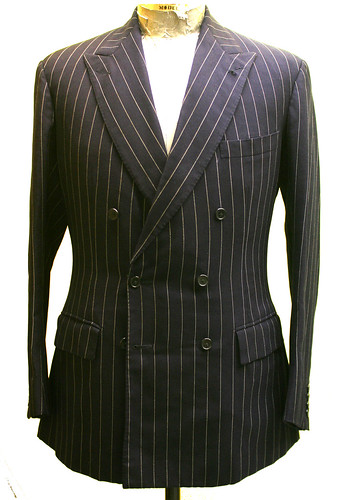
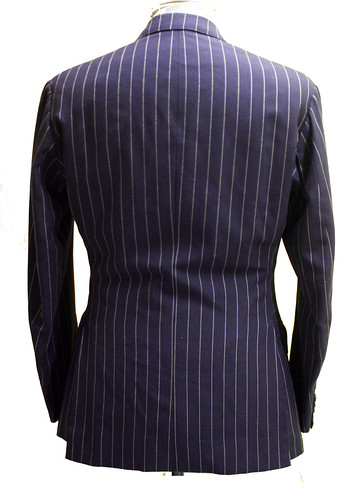
A&S has a possibly unwarranted reputation for cutting shapeless sacks. Certainly the ones I have seen were ugly things. But not this one; instead of wide, droopy shoulders, it has a moderately wide, softly padded shoulder which is in balance with the rest of the garment. And there is a shape. The most shapely garment I have ever examined. A huge drape allowance on the back, and ugly, bizarre sleeves. But shape- good shape. So, curious, I tried it on. It’s not my size, but I know about putting garments on my body which are not my size.
And then I paused again.
I think I stood looking in the mirror for a full fifteen minutes. Looking past the awful sewing, and some of the stylistic things that bug me, this silhouette did not look bad at all. I even caught myself thinking that if the cloth were not in such rough shape I could cut it down and wear it myself. Then I started moving around, and thought, damn, this thing IS comfortable. Then I had another look at the chest and the drape there. It was not the lumpy chest I was used to seeing, but a nicer fold, a real drape, not just bulk, and I can honestly say that at that moment I got it. I understood it. I also understood the bias canvas business, I think, but we’ll get to that.
The thing is, though, I suspect this is the work of Colin Harvey. The skirt has a flare that reminds me of the Prince of Wales’ garments, which were cut by Mr. Harvey. The C on the label would bear it out. So either there was once a maverick cutter at A&S whose work I can appreciate, or there was once a house style infinitely more palatable than what is being done now, which is possibly lost in time. Whatever the case is, keep in mind that the following is, after all, a review of a 20-year old garment and can’t be taken for a reflection of the house today since there have been a number of changes of staff. We hope there were changes in the level of quality as well.
A DB three by two and a single forward pleated trouser with side tab closures; I understand that it is unusual that this coat had a front dart and a separate side body which helps to give it shape.
Here we see the massive back drape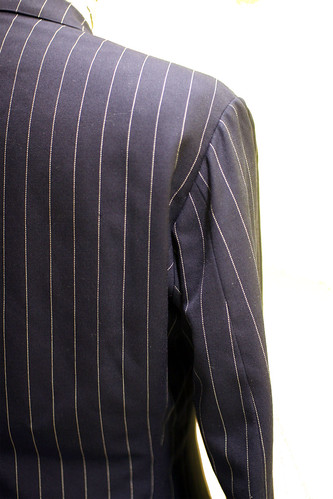
And a sleeve which I find atrocious but which I have actually concluded will give you more movement than a cleaner one. More on that in another post.
I won’t bore you with all the gory details, just some of them. And you may think I’m being nitpicky about silly things like pattern matching. But pattern matching is a sort of signpost. There are so many details in a garment that you can’t see, that we pay special attention to certain details like pattern matching as a sign of the level of attention to detail. If the things you can see are not done well, you can assume that the things that you CAN’T see are also not done well. So while I can see the rest and judge it, you may not be able to. That’s why pattern matching and things like that are important.
A&S is one of the few that bother to match the pocket jets, as a sign of their attention to detail. It is sad, then to see one pocket so madly mismatched.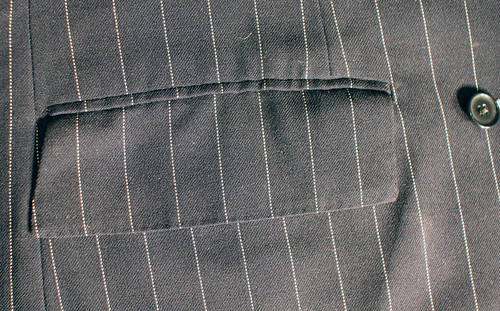
The other pocket is much better; maybe it was the tailor’s excitement in doing a much better job on this pocket that led him to forget to pick stitch it. I am joking in part, but not about the forgetting to finish it part.
The collar is another spot- the collar should match the back. Like the pockets, they got one side right, just not both.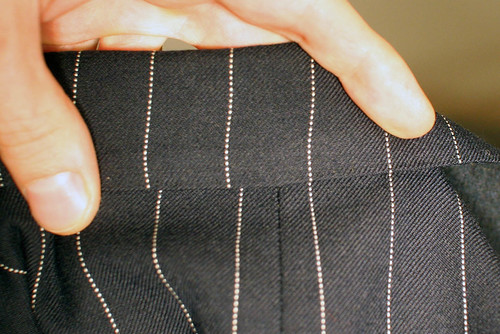
Their much-vaunted hand-sewn armhole seam is coming apart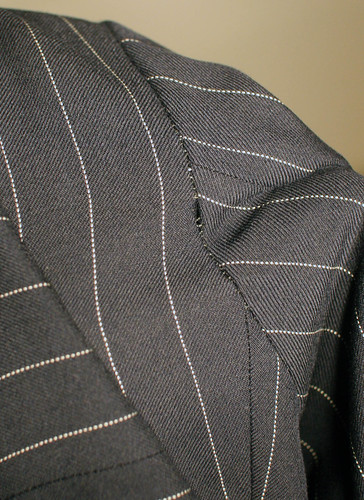
as is the gorge.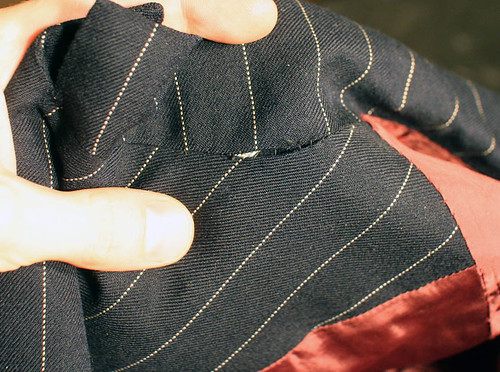
The tab closures are sloppy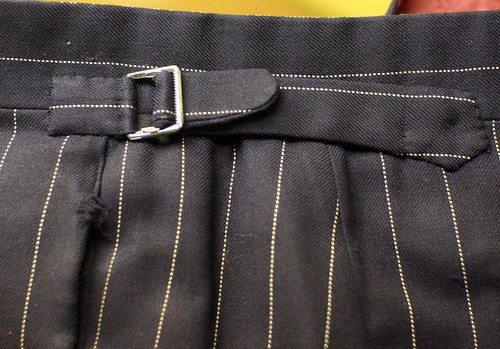
And the breast welt has sagged so much that the facing seam shows.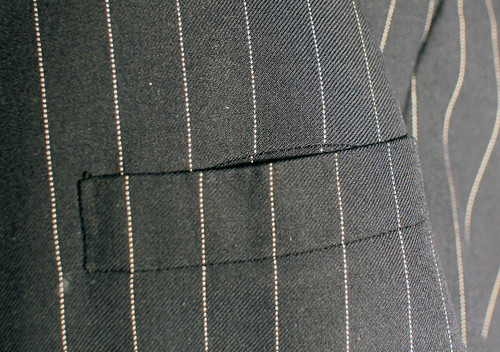
In a previous post I remarked that, while scrounging on ebay I was surprised by the lining, thinking that they had taken the step of cutting the inside pockets directly onto the lining, which is not only weak, but makes lining changes difficult. When I put my hands on the Huntsman and Poole garments I found I was wrong and they had been carefully crafted by hand to resemble the cheaper way of doing it, but the pocket was actually mounted on concealed cloth and in a way which made changing the lining easy when it wore out.
Imagine my surprise to find that not only has the lining been inserted by machine, but the pockets are cut directly onto it, the way I initially feared they would be. And they are absolutely sloppy pockets.
And this is what happens over time when we make sloppy pockets, only now it is a big job to change the lining because of the way it was initially made.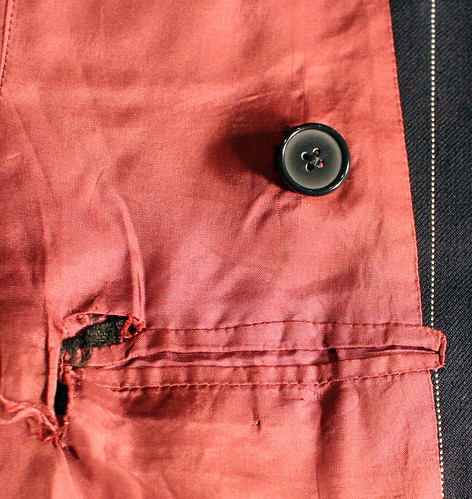
The hem is sloppy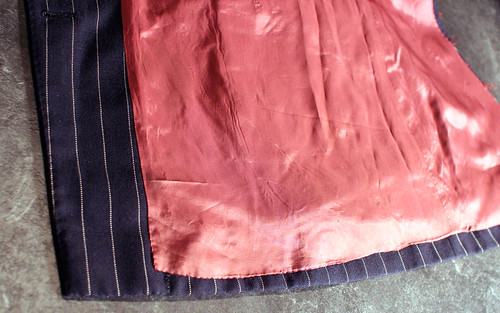
And the neck is worse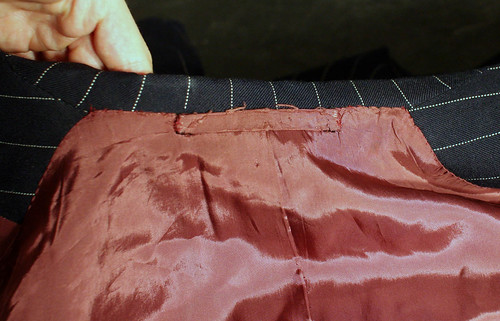
The trouser finishing is no better, and to add insult to injury, they have used black thread on red lining. In several spots of the trouser and the coat.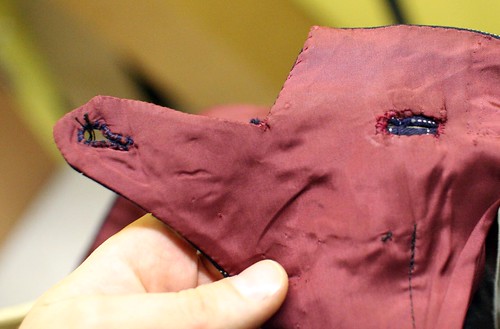
Then things get more interesting. The linen canvas, which was expected, is cut on the straight grain, which was not. They are known for cutting their canvas on the bias.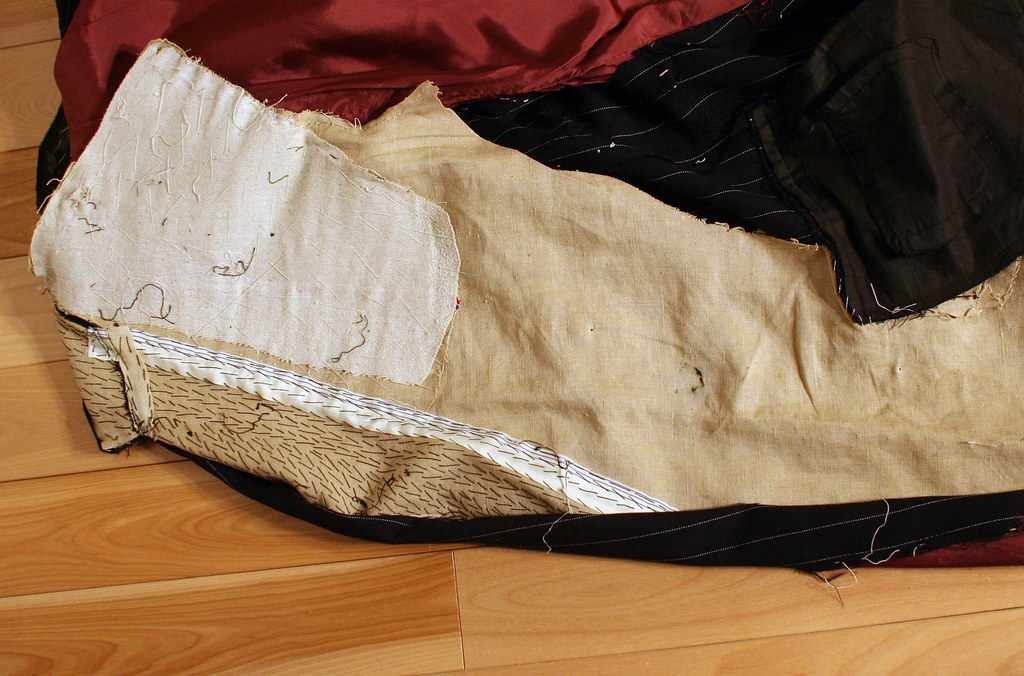
Their MD has explained that bias-cut canvas has the benefit of stretching in the length, to which I say “So what?” The coat does not stretch so why should the canvas stretch? There is no vertical tension on the coat, it does not button up under your crotch or get hooked onto your plus-fours, so why the need to stretch? It makes no sense at all.
BUT the merits of bias-cut cloth have long been known because of its unique ability drape. Ah. Vionnet was a genius with bias-cut cloth and was a huge influence on my dress-making days. Aside from stretching, the bias allows cloth to roll in a way that the straight grain does not. So if the drape in the chest were allowed to roll, a bias-cut canvas would help it. THIS would make total sense. So maybe old John is ad-libbing instead of sticking to the script. In any case, it will only roll if it is not impeded by the chest canvas which usually extends into the armhole.
We see here that the chest canvas is cut well clear of the armhole; this will allow the excess cloth cut for the drape style to fold near the scye instead of puffing out like a swelled chest would do. Taking off the domette we can see that there is haircloth underneath, just a smaller, carefully positioned piece.
Unfortunately, the haircloth is of a very bad quality and is migrating- you can see the hairs jutting into the armhole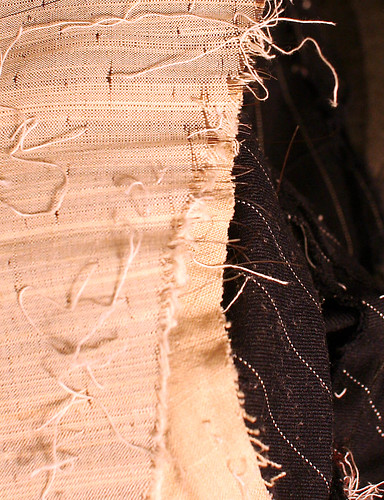
And the fact that I can pull it out easily shows there is no crimp to the hair which would have prevent this migration. It would also have prevent the vee from coming apart at the shoulder as it did. When you feel prickly, plastic-like things poking your chest, it is probably bad haircloth that is migrating like this one.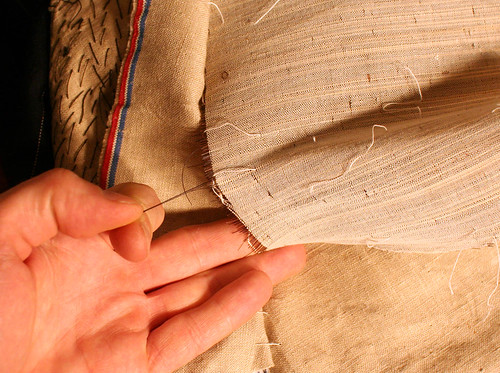
The shoulder has one little piece of wadding supported by a piece of linen and covered by a layer of lining. Just a whisper, but it is enough since the shoulders are not exaggeratedly wide. The shoulders they cut today need much more support to keep them up, and yet they sag.
What do I conclude from this? Well, I know a few things about drape that I didn't before and see what I did wrong on my previous drape experiment. I also know that it's worth a second look. So stay tuned, as we will be making some more drape.
(I hear the sound of Sator weeping....)
UPADTE
Some comments from Mr. Seitelman which are valid and deserve a response (thank you, Mark)
Dissection is an interesting exercise, and I have followed your blog.
Indeed, Mike Cohen, former president of Oxxford, used to dissect competitors' suits. he knew how to do it so as to put the suit back together.
We follow in Domenico Caraceni's great tradition of examining other people's clothes.
the examination of the this suit is not necessarily a fair example of A & S workmanship either back in 1987 or today.
I was quite clear that it is not a reflection of their work today.
For example,
1. It is a 22 year old suit which has been worn to death in probably rain, snow, etc.
I have taken this into consideration and not shown the parts which have worn out due to age and been repaired; the repair work is truly disgraceful and while it would be normal for A&S to do their own repair work it is not a given. What has been shown is, in my opinion, the result of sloppy work or faulty trimmings (with one exception).
MS-2. Due to its age, it is to be expected that a much of the hand sewing would be coming apart especially if it were worn regularly. Similarly, the canvases would age. Does not a brick building require repointing every 20 years? I would say that if the suit had been relined, some of the issues with the canvas would have been corrected.
I agree with you, however one of the arguments that many use as a justification for hand sewing is that it is supposed to be stronger and last longer, which is often not the case, just the opposite. I merely intend to illustrate that point. The canvas would have to be replaced to correct the hair migration and I doubt they would have done that in the course of a reline. It's a problem with the material they used which caused it to fall apart.
3. Due to age and perhaps poor maintainence there would be sagging of certain parts, such as the outside chest pocket.
The breast welt is usually made in such a manner such as the facing seam will never show, even if the pocket should sag. This pocket was badly made.
4. We do not know if this suit were made for a customer or for one of the cutters or tailors. If it were made for an A & S employee, then certain shortcuts might have been taken to get the suit done quickly.
This suit was not made for an employee, it was made for a person who is known to the public. I have obscured his name on the label for privacy.








20 comments:
your blog continues to astound me. never before have i looked at things the way you do and i hope to learn more.
As these deepdish dissections of bespoke clothes continue, I find myself growing angrier and angrier with the unmitigated gall of certain revered Savile Row tailors espousing their superiority with fit and finish. The visual evidence and your observations show just the opposite. It doesn't even pass the giggle test. Any cutter and tailor can have an off-day with shears or needle and thread, I suppose, but every bespoke example seen so far leaves me underwhelmed.
Thank heavens for the refreshing Saint Andrews coat, a mix of manufacturing and hand-tailoring with great attention paid to details. It bodes well for upscale menswear.
I'm not suggesting bespoke tailoring has had it, far
from it, but the old firms on the row seem to have lost their grip. Hmm, perhaps your next longform project should explore top tailors and manufacturers in North America and Italy.
JMB
Thank you again, J. Truly amazing stuff.
Thank you for a fair yet frank assessment of this garment and your mature perspective on what it says about its makers 23 years on.
Why would someone agree to pay for such poor work? Bespoke is expected to be much better than average, not just a nice label.
Keep up the great work! This really is a great read.
If people don't like bespoke, they shouldn't buy bespoke. It is a pretty basic concept that doesn't require rationalization.
You should send a note to Edwin to ask if the label is coded for the cutter or not.
- voxsartoria
Dissection is an interesting exercise, and I have followed your blog.
Indeed, Mike Cohen, former president of Oxxford, used to dissect competitors' suits. he knew how to do it so as to put the suit back together.
However, the examination of the this suit is not necessarily a fair example of A & S workmanship either back in 1987 or today.
For example,
1. It is a 22 year old suit which has been worn to death in probably rain, snow, etc.
2. Due to its age, it is to be expected that a much of the hand sewing would be coming apart especially if it were worn regularly. Similarly, the canvases would age. Does not a brick building require repointing every 20 years? I would say that if the suit had been relined, some of the issues with the canvas would have been corrected.
3. Due to age and perhaps poor maintainence there would be sagging of certain parts, such as the outside chest pocket.
4. We do not know if this suit were made for a customer or for one of the cutters or tailors. If it were made for an A & S employee, then certain shortcuts might have been taken to get the suit done quickly.
Many are indignant in what they perceive to be the drop in quality on Savile Row. I do not pretend to be an expert on the historical quality level, but I do not think the quality has dropped over time.
Just a thought.
Once upon a time there was a hare named George who, boasting how he could make finer clothes than anyone else, was forever teasing Domenico the tortoise about his superiority. Then one day, the irate tortoise answered back: "Who do you think you are? There's no denying you're good, but even you can be beaten!" The hare squealed with laughter.
"Beaten in a contest? By whom? Not you, surely! I bet there's nobody in the world that can win against me, I'm so good. Now, why don't you try? A pair of Golden Shears as the prize!"
Annoyed by such bragging, the tortoise accepted the challenge. The hare yawned sleepily as the meek tortoise trudged slowly off. When the hare saw how painfully behind his rival was, he decided, half asleep on his feet, to have a quick nap. "Take your time!" he said. "I'll have forty winks and catch up with you in a minute."
Domenico’s cousin sent him clothes that George had made so Domenico could study them. Then Domenico went up north to see what some of his cousins were doing. Then Domenico brought some American tortoises over to teach him how they worked. Domenico knew he had to improve a little bit every day in order to catch up with George so every day he tried to learn something new.
The hare woke with a start from a fitful sleep and gazed round, looking for the tortoise whop was playing with some old rags. Breathing a sigh of relief, the hare decided he might as well have breakfast too, and off he went to munch some cabbages he had noticed in a nearby field. But the heavy meal and the hot sun made his eyelids droop. With a careless glance at the tortoise hunched over rags, he decided to have another snooze before dashing off a garment. And smiling at the thought of the look on the tortoise's face when it saw the hare’s magnificent tailoring, he fell fast asleep and was soon snoring happily. The sun started to sink, below the horizon, and the tortoise, who had been working away, was painstakingly adding tiny little stitches to his own suit. At that very point, the hare woke with a jolt. He could see the tortoise giving a finish press with startling precision, and he dashed to his cutting board. He chalked and cut stitched at a great rate, his tongue lolling, and gasping for breath. Just a little more and he'd be finished. But the hare's last effort was just too late, for the tortoise had won the golden shears!.
Mark Seitelman makes an interesting point. If you run a bespoke suit into the ground from overwearing it, commercial dry-cleaning, or binge and purge cycles of stuffing your face and dieting, that pricey outfit from London will come apart at the seams and have a short lifespan. So will you, come to think of it, if you turn into a sloth and don't exercise daily.
Where I differ from Seitelman's point is this: a decades' old suit need not necessarily look like this tatty old A&S schmata. If being well-dressed is important to you and you can pay for a wardrobe, replete with accessories, it is incumbent upon you to learn about cloth, to learn how to have a dialogue with your cutter and tailor, your shirtmaker, your bootmaker and, above all, how to properly care for your clothes. If you've never pressed or ironed a garment, take a look at some of the past entries on Jeffery's blog. Try your hand at it. There's a wealth of information here!
JMB
Jeffery, that was fascinating, thank you. I'll endeavour to lay my hands upon a more recent garment for comparison purposes.
Thank you for discussing my comments.
This suit may not be representative of A & S because each coat is the unique product of a single coat maker. In comparison, an assembly-line product, such as Oxxford, is pretty uniform inside and out.
I recall John Kent's quote in the Walker book to the effect that he does not micro-manage his coat makers. He does not tell them how to make the coat and the type of canvas and inner materials. Otherwise, he said that you would wind-up with "rubbish."
I have noticed some quirks and differences in my various coats from Davies & Son.
I think that one reason for the quirkiness and individuality is the use of "out-workers". The out-workers in their shops or homes are not closely supervised. I am not saying that the out-workers are not skilled (indeed, there are so few of them!), but each one has his way of doing things dating back to his apprentice days.
Furthermore, both bespoke makers and factories change the materials that they use. I recall Martin Greenfield telling me a few years ago that he changed to a much improved and lighter canvas. Similarly, Oxxford uses a featherlight canvas on some of its summer coats. Therefore, A & S may be using a different canvas at this time.
Thank you, Mark.
You may not know that I work in the RTW industry and am familiar with the different ways of making things. In fact, I think it is the assembly-line industrialization that has allowed many makers to catch up with, and perhaps surpass, some of the more artisanal makers for reasons you mention; repetition and specialization breeds perfection, in my opinion. Someone who only makes pockets, for example, will become extremely good at making pockets, and will likely make a better pocket than the person who makes a coat start to finish. Otherwise, why have a separate cutter and tailor? Why have a separate coat and trouser cutter? Specialization. Huntsman had a compartmentalized system for this very reason, which was later dismantled. It is also one thing to make one suit; when you make a dozen or a hundred which are supposed to be identical you begin to notice the more minuscule flaws and variations and become attuned to them- in a factory setting we have to decide which flaws to let pass in order to meet budget constraints, but where quality is the very first priority, beautiful things can be made.
J
Excellent Jeffey and keep up the good work! Maybe someone has a newer AS garment that does not fit anymore and this person is willing to donate it for one of your dissections.
I'd really love to see that.
Alternatively, each of us could send you $10 by paypal and eventually you could buy another garment on ebay...
What do you think of that?
You note in passing that you believe the cutter was Colin Harvey. For what it's worth, I agree. Mr. Harvey was my cutter for several years before his untimely deathlistic hallmarks of this garment point to him: the large blade and ever-so-slightly extended shoulder, the very large upper arm crammed into a very small and high armhole, the full chest, and particularly the small waist. Harvey was forever saying to me at fittings, "I think we can give you a bit more shape, Mr. Boyer." He was an incredibly stylish man himself, and a great cutter. I'm sure he is missed by many. Sincerely, G. Bruce Boyer
Thank you, Bruce. Was this typical of A&S at the time, or a caprice of Mr. Harvey's?
Boni, thank you for the offer; these dissections can be expensive but I don't think it would be proper to try to collect money for them. I will continue to do these as long as I can find interesting garments and feel that there is still interest.
J
Jeff - another great post. As a bit of an aside, I'd like to dig up my old obsession: did this coat exhibit shiny elbows? Any idea about what cloth it is made of?
Thanks!
-The Louche
No shiny elbows but a shiny seat on the trouser. I wish I knew what the cloth was- I like the hand.
J
Another great article. I'm impressed that a vintage A&S suit couple melt your pagoda-shaped heart. Looking forward to your next experiment in drape.
The C is part of the customer's pattern number.
Post a Comment